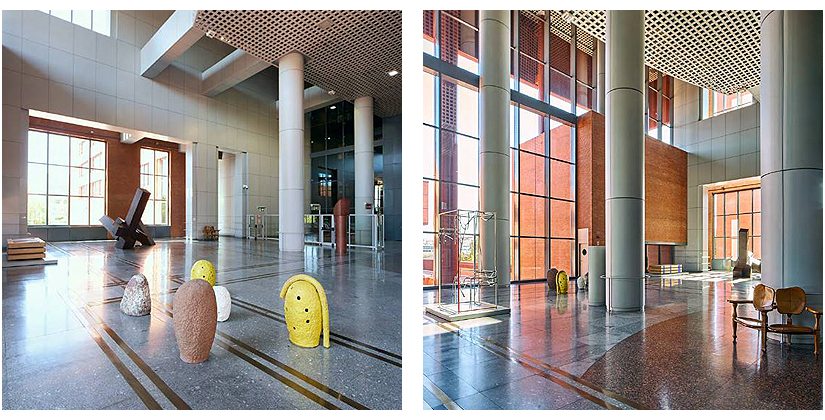
Sculptures at Banco de España offices at Alcalá 522
The Banco de España's second Madrid headquarters was designed by José Antonio Corrales![]() and Ramón Vázquez Molezún
and Ramón Vázquez Molezún![]() and opened its doors in 1992. It houses a large number of pieces from the Collection most of which have been added in recent decades, when the institution has stepped up its acquisitions policy. In this piece, we are going to focus on the sculptures in the vestibule and portico. In subsequent articles we will discuss the works housed in other areas, such as the auditorium and canteen.
and opened its doors in 1992. It houses a large number of pieces from the Collection most of which have been added in recent decades, when the institution has stepped up its acquisitions policy. In this piece, we are going to focus on the sculptures in the vestibule and portico. In subsequent articles we will discuss the works housed in other areas, such as the auditorium and canteen.
Presiding over the vestibule is one of the most iconic sculptures in the collection, In Praise of Discontent (1991), by Jorge Oteiza. This is the last piece Oteiza ever made and was specifically designed for this space. Together with Red Sphere, by Jesús Rafael Soto and Untitled, by José María Cruz Novillo, it was one of the first site-specific works commissioned by the Banco de España. By the early 1990s, Oteiza had largely abandoned his artistic work to devote himself to writing. However, the keen interest shown by the architects and the then deputy governor of the bank, Ángel Rojo, were decisive in persuading him to accept the commission.
This imposing three-metre work in Corten steel was based on some maquettes Oteiza had made in his Chalk Laboratory in the early 1970s. These formed part of a design for a planned public sculpture for Madrid's Paseo de la Castellana, which ultimately failed to materialise. To some extent, the 'discontent' of the title is an allusion to that experience.
 Francisco López Hernández: The Fig Tree (1984) | Pablo Palazuelo: June Days IV (1990)
Francisco López Hernández: The Fig Tree (1984) | Pablo Palazuelo: June Days IV (1990)
In addition to Oteiza's work, Alcalá 522 houses a variety of sculptures, all made between the mid-1980s and the early 2000s. The oldest is The Fig Tree (1984), a bronze bas-relief by Francisco López Hernández, which was originally installed in the Banco de España's offices in Cadiz. As Isabel Tejada explains, the strong metaphorical and symbolic charge of this piece is reminiscent of the paintings of Pompey, with which the Madrid artist was very familiar. The sculpture stands at the entrance to the building, alongside June Days IV (1990), by Pablo Palazuelo, a work that highlights the essential role that nature —and the emotions produced by living in it— play in the artist's investigations of the abstract.
Of the works in the vestibule, the oldest is Fontana nº 1 (1985) by Susana Solano For this highly poetic piece, the Catalan artist worked in iron, a material closely linked to the tradition of avant-garde sculpture. It is also worth noting that until that time, the use of iron had been almost exclusively confined to male sculptors in Spain. The next two pieces in chronological order are in iron and steel: Stratford 3 (1989-1990), by Txomin Badiola, in which the Bilbao artist seeks to break with the conservative rigidity of the formalist Basque sculpture in which he had been trained; and Cabota (1990), by Miquel Navarro in which the Valencian creator uses one of his frequent totemic structures to make a critical reflection on power.
 Two views of the entrance hall of the Alcalá 522 building, showing sculptures by Xavier Toubes, Pello Irazu, Miquel Navarro, Florentino Díaz and Jorge Oteiza.
Two views of the entrance hall of the Alcalá 522 building, showing sculptures by Xavier Toubes, Pello Irazu, Miquel Navarro, Florentino Díaz and Jorge Oteiza.
The works in the vestibule by Pello Irazu, Francisco Leiro and Xavier Toubes all date from 1992, the year the building was opened. The two by Toubes, Water-Yellow and Grapes, are ceramic pieces, standing mid-way between sculpture and painting. As Beatriz Espejo explains, they function as metaphors of the body and the erotic. In making them, the artist has drawn heavily on the processual and the random. The corporeal reference is more explicit in Statue, made from an assemblage of different pieces of wood combined with synthetic materials such as polyester and light bulbs. To a great extent, the piece marks a return to Francisco Leiro's surrealist roots. Pello Irazu's Nobody Told Me You Were Here is more conceptual in nature and is a very representative example of his heterodox approach to minimalism and the figure of Oteiza. As Isabel Tejada writes, it is an approach that has led Irazu to create works "of great material density that produce a spatial discontinuity wherever they are installed".
The most recent sculpture housed at the Alcalá 522 building —an austere architectural block, notable for its strongly horizontal composition— is LCDF XV (2001), by Florentino Díaz, Using stainless steel, paint and rubber, here the Cáceres artist continues her critical reflection on the liquid condition, using Zygmunt Bauman's notion of the contemporary world, one of the central themes of her prolific artistic output.
